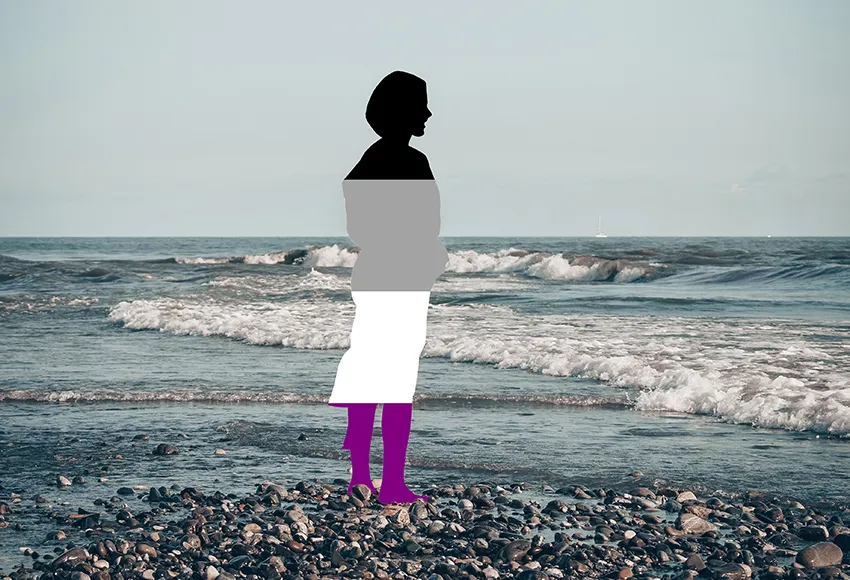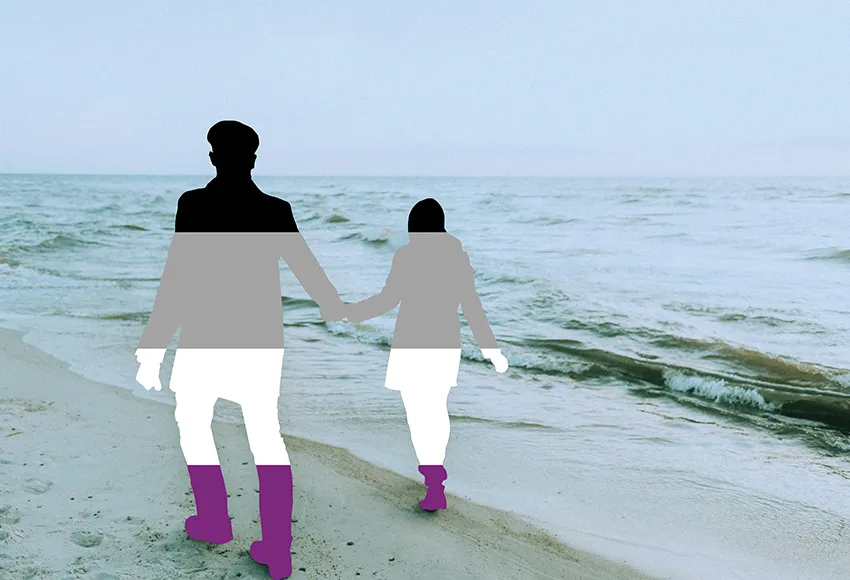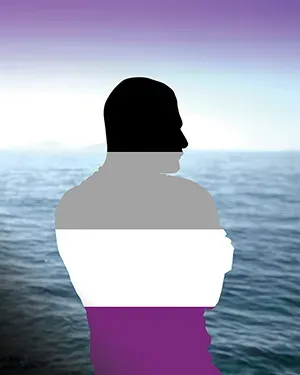Love is a battlefield.
While Gay, Straight, and Bisexual people alike unite in the fight against heartbreak and in the desire to settle into a "happily ever after," one subset of the LGBTQ+ community has to fight to even be recognized in the ranks.
"Asexuals have been fighting for visibility within the community for 40 years," said Aubri Lancaster, an Asexual sex educator.
"The problems of marginalization of asexuality come in a few different forms," Lancaster explained. The most basic form marginalization is rooted in the fact that many fail to understand what asexuality is. Just as humans tend to do when they don't understand something, many pretend that it doesn't exist.
"So, in the sense of the frameworks of... sexual orientation, we don't exist," Lancaster explained. "You know, we're the 'A,' so we have to define ourselves in terms of the frameworks available to us today. So, in the sexual orientation framework that asks, 'Who are you attracted to?' our answer is 'no one.'"
What is Asexuality?
Asexuality is much more complex than just a lack of sexual attraction. According to Lancaster, the label "Asexual" can work as both an orientation and an identity.
As an orientation, asexuality is simple – it is the absence of attraction.
However, as an identity, it is complex. "There are also people who consider it as an identity more so than an orientation, because it is, for them, [more] about their lifestyle and their relationship to sex... than their relationship to attraction," Lancaster said. "So it can be a little bit of both."
Attraction can be separated into two different forms: romantic and sexual. One who does not feel a sexual desire for others but does experience romantic attraction would typically be considered Asexual (or Ace). On the other hand, one who feels sexual attraction but does not have the desire to form romantic connections or attractions with others would be Aromantic (or Aro).
Someone who experiences sexual attraction at any level would be considered "Allosexual" (or Allo) just as someone who does experience romantic attraction would be considered "Alloromantic."
"I am Alloromantic, so I do experience romantic attraction, but I do not experience sexual attraction," Lancaster added.
"Romantic attraction is a kind of limerence," Lancaster explained. "It's about feeling a need for reciprocation of feelings and love. So, you can have a long-term relationship of either a platonic nature or a coupled nature or a multirelation, and it can build into a kind of love that we call 'affectionate bonding,' and that doesn't have to come through the experience of limerence. You can grow to love someone without going through that period of falling in love."
For some members of the Asexual community, sex can still be enjoyed and even desired. This is because asexuality, like any other identity, exists on a spectrum.
"Of course, there's going to be [places] in between," said Lancaster.
"Some people will experience sexual attraction but either rarely or only under certain specific conditions. Demisexuality is somebody who experiences sexual attraction only after an emotional connection has been made. So, they need to have an emotional bond with somebody to experience sexual attraction, [though] an emotional connection does not guarantee sexual attraction. Similarly, some people need intellectual attraction to experience sexual attrition – that's sapiosexuality."
Often people who identify as somewhere along the spectrum of Asexual to Allosexual fall under the umbrella term "Greysexual." While some may find these labels confusing, they're a valuable way for people to communicate their needs and boundaries and find community.
For someone like Lancaster, who identifies specifically as Asexual, dating, love, and romance are certainly not off the table, even if sexual attraction is.
However, discovering her identity and learning how to communicate her preferences was not an easy journey. "As an Alloromantic Asexual, I spent a lot of time when I was young not understanding any of it and just falling for different people in a typical way. It wasn't until the relationship moved on beyond the falling-in-love stage and into 'how are we going to continue to have this relationship,' what's going to be involved, and the expectations of sex around that that I started to hit difficulties."

Amatonormativity
Societal expectations around sex and love exposed a gap for people like Lancaster, who felt love and attraction but did not necessarily connect those feelings to sex. "We put a lot of emphasis in our society on romantic sexual relationships," she said. "There's a term for that. It's called 'amatonormativity.'"
Amatonormativity is a term coined by Elizabeth Brake, professor of philosophy at Rice University. "It says that our society creates a hierarchical structure that prioritizes sexual and romantic relationships over all others and assumes that everybody wants a sexual and romantic relationship, and to have a happy and healthy life you need to have that, and it needs to be exclusive and monogamous," Lancaster explained.
Brake's social theory elaborates on the idea that society values romantic and sexual relationships so much that platonic relationships are often overlooked and undervalued for their importance for our mental health and well-being.
"The assumption that valuable relationships must be marital or amorous devalues friendships and other caring relationships, as recent manifestos by urban tribalists, quirkyalones, polyamorists, and Asexuals have insisted. Amatonormativity prompts the sacrifice of other relationships to romantic love and marriage and relegates friendship and solitudinousness to cultural invisibility," Brake says.
Brake built her philosophy on the foundation of the widely accepted idea of heteronormativity – the assumption that all people are straight until proven otherwise, typically by coming out. "Amatonormativity overlaps with heteronormativity," said Brake. "Like heteronormativity, it can be found throughout social life, and it can be understood concerning other systems of oppression, for example, in its relation to gender roles.
"Heteronormativity can be understood by considering what counts as violating it: the subversion of gender roles or displays of same-sex sexuality. Violations of amatonormativity would include dining alone by choice, putting friendship above romance, bringing a friend to a formal event or attending alone, cohabiting with friends, or not searching for romance."
Lancaster experienced amatonormativity firsthand. "I was married for seven years to my ex-husband, and we had very different levels of sexual desire," she said. "It was a lot of pressure and a lot of feeling broken. So, when I got out of that relationship, I decided I wanted to find somebody that was truly intellectually compatible with me before I let my heart fall in love with them. And to put it out there that sex is not the most important thing for me."
Ace dating
After her divorce, Lancaster entered the dating world again. This time, she was more aware of what she was looking for. "You can fall in love with somebody without wanting to have sex with them," she said.
However, she added, "I am sex favorable, which means that I am open to the idea of sex, basically for fun and as a way to bond and be emotionally close. It feels good, but I don't need it, and my idea of frequent is not 'typical.'"
While there is no "right" way for Asexual people to meet and date, Lancaster suggests using dating apps that center on personality instead of more superficial swiping apps like Tinder and Grindr.
"I found my [current] husband on OkCupid, and I made sure that I found somebody that I matched with intellectually, so when I was sure that I had that kind of match, I was able to kind of let myself fall in love," she says.
Lancaster, like many other members of the Ace community, is in a relationship with an Allosexual partner. She says relationships with Allosexuals can work, but both parties need to communicate their needs.
"It's important to be able to understand that you don't owe your partner sex, ever. Relationship dynamics are different from person to person, but finding other ways to connect that don't center sex in the relationship is important. Some people are going to be more receptive to that than others. It can be an emotional conversation or several conversations," she said.
As far as dating advice goes, Lancaster is aware that dating for Ace and Aro people can be difficult. For one, there are no good Ace dating apps on the market at the moment. "Most are just full of bots," Lancaster said. "Honestly, people dismiss it, but I swear by OkCupid. I met my husband there 13 years ago," she laughed.
While OkCupid is Lancaster's app of choice, she says there are specific steps Asexual people should take when using the app. "The biggest thing is you need to answer at least 500 questions, if not more, and only look at other people who have also answered 500 questions and have a 90% match rating, otherwise don't try and have a relationship with somebody that you haven't had the chance to vet," she said. "And only respond to personalized messages. If it could be copied and pasted, delete it. It's spam."
The most important dating tip she has for any circumstance, either online or in real life, is to "be up-front and honest about your orientation, because if that's a deal breaker, let them weed themselves out. You deserve somebody who will see your asexuality as a feature, not a challenge."
Lancaster also suggests doing some self-reflection to figure out how you feel attraction outside of amatonormativity. "Because it is assumed that sexual attraction and romantic attraction are inseparable, a lot of people will spend their life like I did, not realizing that they're Asexual because they don't know that those things can be separate for some people. So, it is an issue of the amatonormativity, compulsory sexuality, and society telling us that to be human we have to experience sex and love."

Allyship and mental health
For people who want to be a better ally to Asexuals, reframing the way we view romantic relationships and attraction as pillars of adulthood and humanity is a good start.
"Being able to step back and recognize that there are aspects of these experiences that we don't share and being able to visualize what a happy and healthy life might look like without those things is a major challenge," said Lancaster. "It is a huge cause of stress for Asexual and Aromantic people, and, according to the Trevor Project, Asexual people have a higher suicide rate than any other orientation."
The statistics about asexuality and mental health are staggering. One of the reasons it can be so hard for Asexual people to come out is a lack of acceptance and understanding, both from heterosexual and LGBTQ+ communities.
"I find that there are a couple of major responses that I'll get. Either people will have an alternative suggestion as to a reason [for my asexuality], such as a hormonal problem, low libido, or sexual dysfunction, or they'll want to fix it," Lancaster said.
Being viewed as a problem instead of validated for their identity causes extreme stress and negativity for many. "They dismiss asexuality as a potential option for themselves or others based on past experiences that don't necessarily have anything to do with attraction. So, they will assume that if somebody has had sex or enjoyed sex that they can't be Asexual. And that's not true."
Labels
Another issue younger Asexual people face is a war against labels. "There are people who worry that taking on a label, especially the younger generation, will prevent them from exploring their sexuality and relationship options. But the truth is, labels are tools. They are tools to help us communicate our needs and boundaries and find community."
Often people are averse to labels because they see them as permanent, but as communities, especially Queer ones, begin to accept fluidity, this notion is also changing.
"We know labels can change; we don't need to be reminded that they can change, because we realized they could change the minute we realized we were Asexual. Because in a heteronormative society, we are assumed to be heterosexual until proven otherwise. Taking on an Asexual label is already a change.
"Taking on microlabels that help us to differentiate our specific relationship with sex and find communities within the [wider] community is valid. When it comes to labels, the best thing a person can do is lean in and figure out what it is that that label is helping that person communicate about their needs."
Intersectionality
Another issue Asexual people face is in the intersections of their identities. Because sexuality is often ascribed to people and assumed by others, it can be harder for some people to identify as Asexual.
"The intersectionality of people of color, who are often oversexualized or desexualized depending on what stereotypes apply to them and their culture, adds another layer to the difficulty [of identifying] as Asexual. You have to translate it through a Western, heteronormative, white perspective that a lot of these things are initially presented through."
Because sex and sexuality are often associated with maturity, Asexual people sometimes have to fight against infantilizing stereotypes. "Asexual people and Aromantic people are infantilized a lot in general. Once again, it's forgotten and ignored that attraction does not equal action. We're still adults, we still have adult experiences, and our relationship to sex does not define that," Lancaster said.
Infantilization impacts more than just the Asexual community. Often people with disabilities and neurodiverse people face similar issues. Embracing sexuality can be a way disabled people fight these stereotypes, but for disabled people who are Asexual, it can be hard to distinguish one identity from the other.
"Disabled people are often desexualized, and I've even heard that issue referred to as assuming disabled people are Asexual. The problem is, some disabled people are Asexual, and disabled people who are Asexual have to fight the [desexualizing] stereotypes that are placed upon them," Lancaster explained.
In the Queer community
Despite "LGBTQ+" functioning as an umbrella term that includes asexuality, many feel excluded from Queer spaces as well.
"Suggesting that Asexuals are going to sterilize a Queer space of all sexual content is just not true," Lancaster said. "And to say that Queer communities are only about sex is also not true. There's a lot of overlap that can work for both groups."
The main issue Asexual people face when trying to assimilate into the LGBTQ+ community is the hypersexualization that comes with Queer pride. It can be hard to fit into a group that unites over sexual preference when you, yourself, do not have one.
"There's, of course, the oversexualization of people in Queer communities. I know some Asexual Gay men who talk about being dismissed in their Gay identity because of their asexuality," Lancaster said.
There is also the issue of straight-passing couples excluded from Queer spaces, which Lancaster can attest to. "[Some couples] are told that if you are cisgender and heteroromantic and Asexual, or cisgender heterosexual and Aromantic, that those cis and hetero aspects preclude you from the community, without understanding that there is still a different experience of sexuality and romance that truly queers the nature of sex and romance in a larger scope."
For Asexuals, love, romance, connection, and community are boundless and do not necessarily require sex or amatonormative relationships.
"We have to break outside of that boundary and that box that they have created for all of society and say some of us don't want those things," Lancaster said. "Some of us value platonic relationships equally, and there can be relationships that are perfectly happy and fulfilling without sex or romance."


